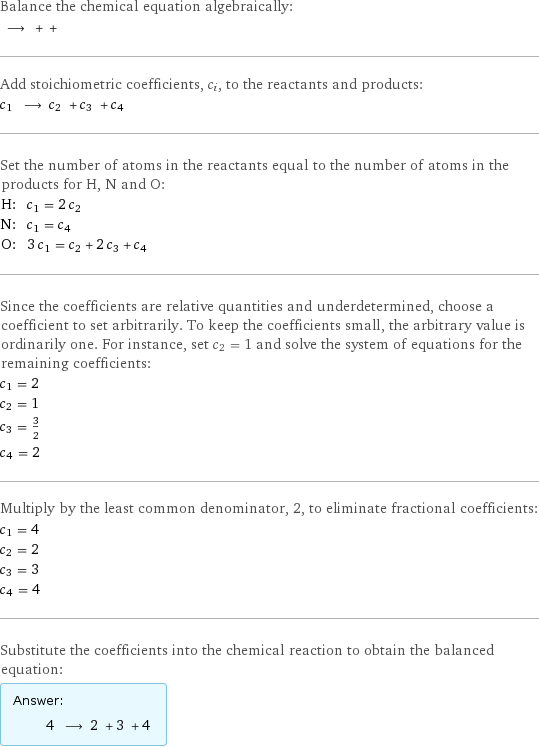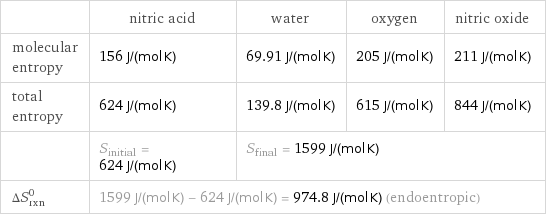Input interpretation

nitric acid ⟶ water + oxygen + nitric oxide
Balanced equation

Balance the chemical equation algebraically: ⟶ + + Add stoichiometric coefficients, c_i, to the reactants and products: c_1 ⟶ c_2 + c_3 + c_4 Set the number of atoms in the reactants equal to the number of atoms in the products for H, N and O: H: | c_1 = 2 c_2 N: | c_1 = c_4 O: | 3 c_1 = c_2 + 2 c_3 + c_4 Since the coefficients are relative quantities and underdetermined, choose a coefficient to set arbitrarily. To keep the coefficients small, the arbitrary value is ordinarily one. For instance, set c_2 = 1 and solve the system of equations for the remaining coefficients: c_1 = 2 c_2 = 1 c_3 = 3/2 c_4 = 2 Multiply by the least common denominator, 2, to eliminate fractional coefficients: c_1 = 4 c_2 = 2 c_3 = 3 c_4 = 4 Substitute the coefficients into the chemical reaction to obtain the balanced equation: Answer: | | 4 ⟶ 2 + 3 + 4
Structures

⟶ + +
Names

nitric acid ⟶ water + oxygen + nitric oxide
Reaction thermodynamics
Gibbs free energy

| nitric acid | water | oxygen | nitric oxide molecular free energy | -80.7 kJ/mol | -237.1 kJ/mol | 231.7 kJ/mol | 87.6 kJ/mol total free energy | -322.8 kJ/mol | -474.2 kJ/mol | 695.1 kJ/mol | 350.4 kJ/mol | G_initial = -322.8 kJ/mol | G_final = 571.3 kJ/mol | | ΔG_rxn^0 | 571.3 kJ/mol - -322.8 kJ/mol = 894.1 kJ/mol (endergonic) | | |
Entropy

| nitric acid | water | oxygen | nitric oxide molecular entropy | 156 J/(mol K) | 69.91 J/(mol K) | 205 J/(mol K) | 211 J/(mol K) total entropy | 624 J/(mol K) | 139.8 J/(mol K) | 615 J/(mol K) | 844 J/(mol K) | S_initial = 624 J/(mol K) | S_final = 1599 J/(mol K) | | ΔS_rxn^0 | 1599 J/(mol K) - 624 J/(mol K) = 974.8 J/(mol K) (endoentropic) | | |
Chemical names and formulas

| nitric acid | water | oxygen | nitric oxide Hill formula | HNO_3 | H_2O | O_2 | NO name | nitric acid | water | oxygen | nitric oxide IUPAC name | nitric acid | water | molecular oxygen | nitric oxide